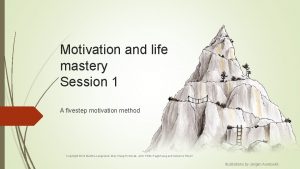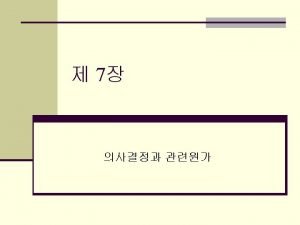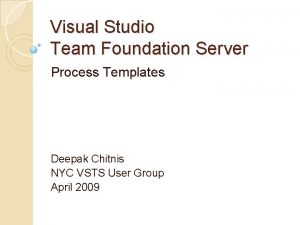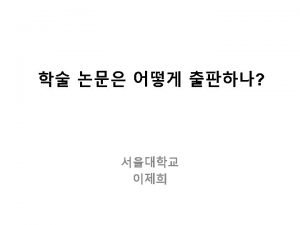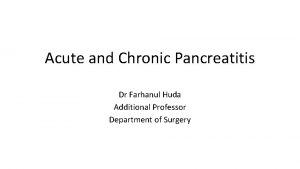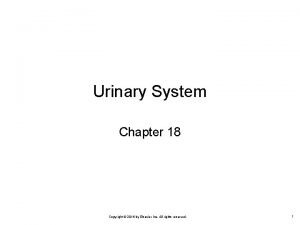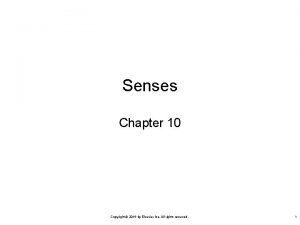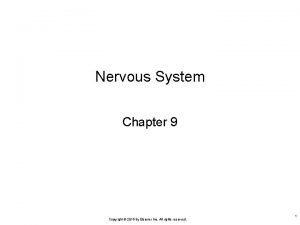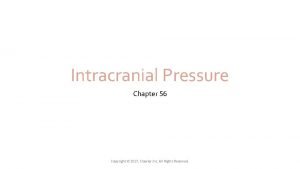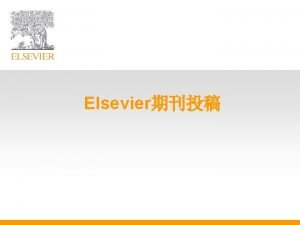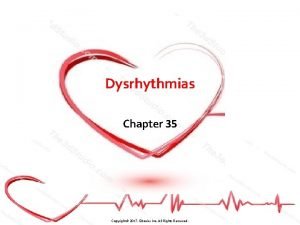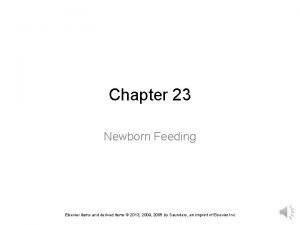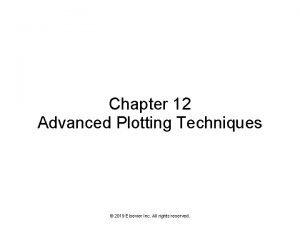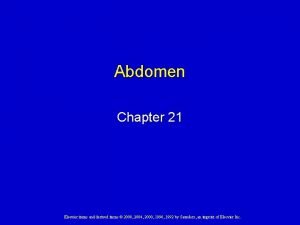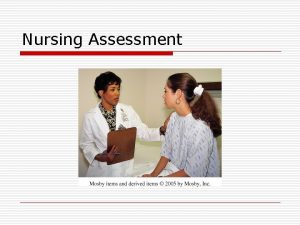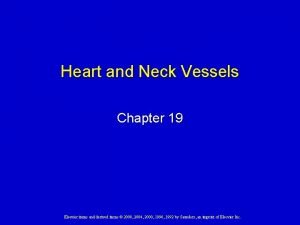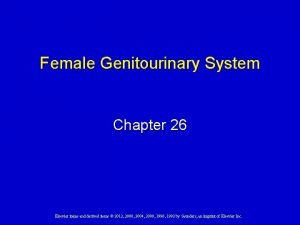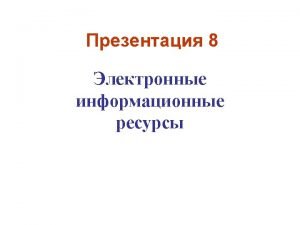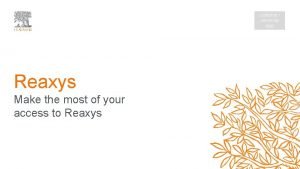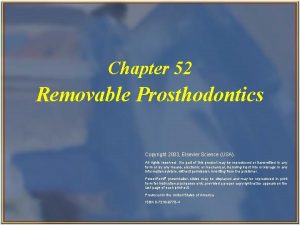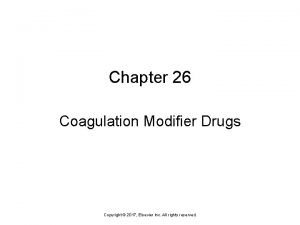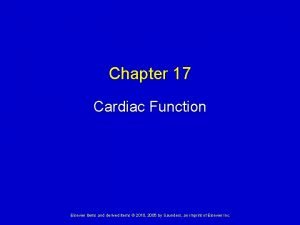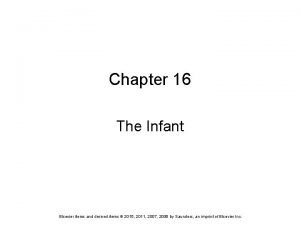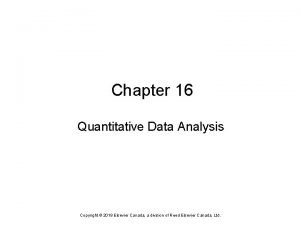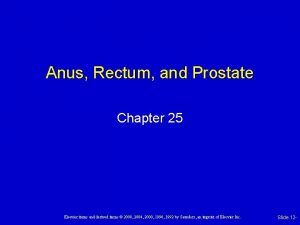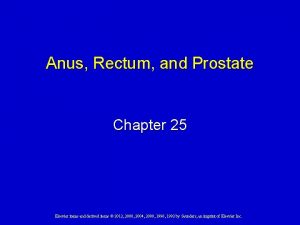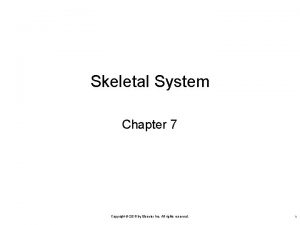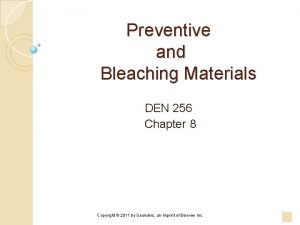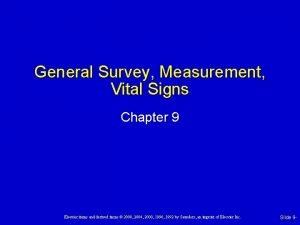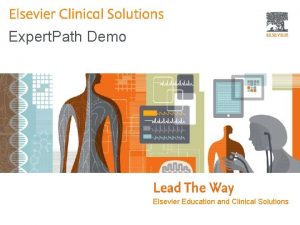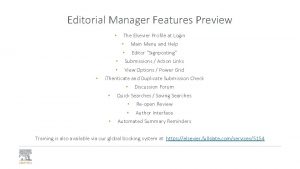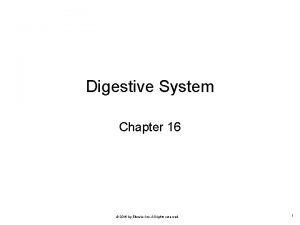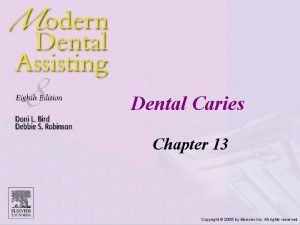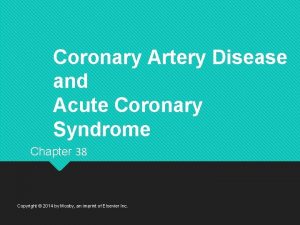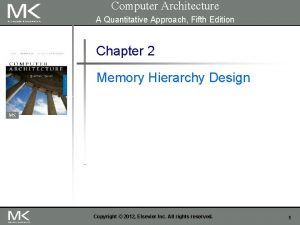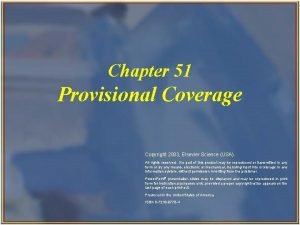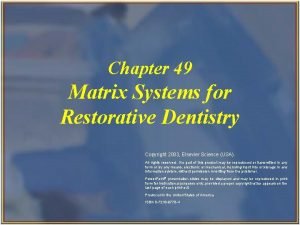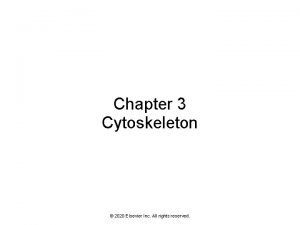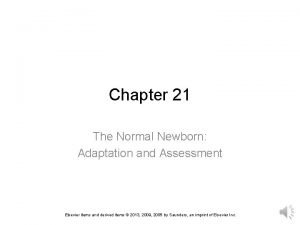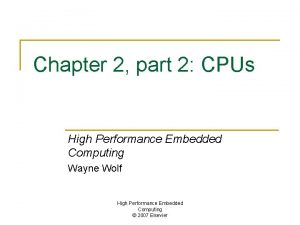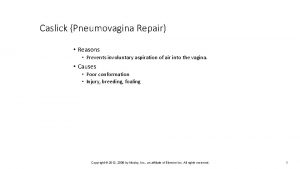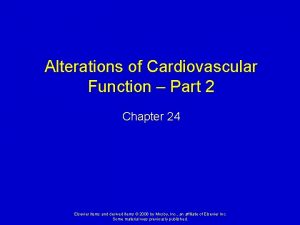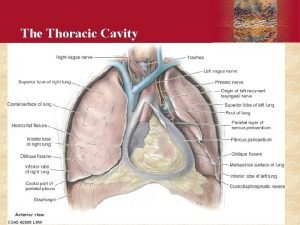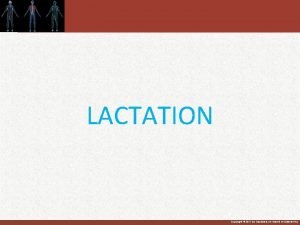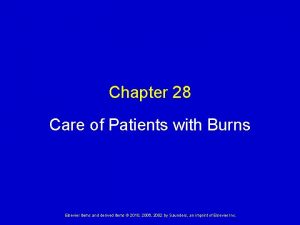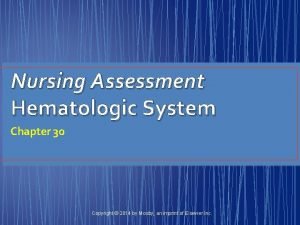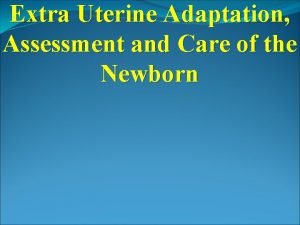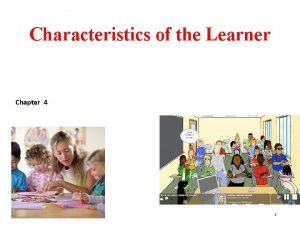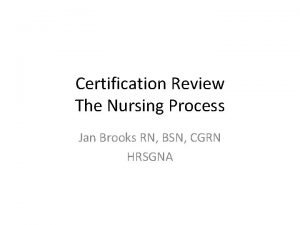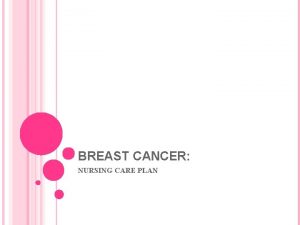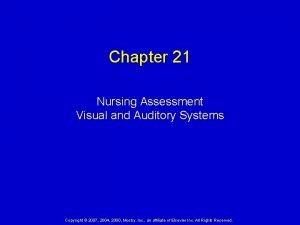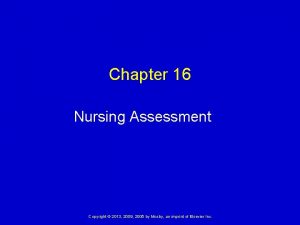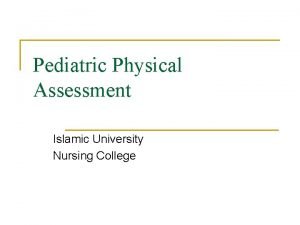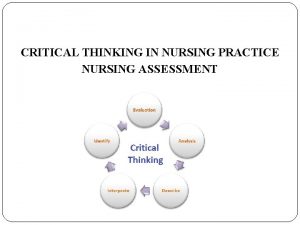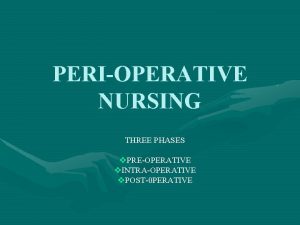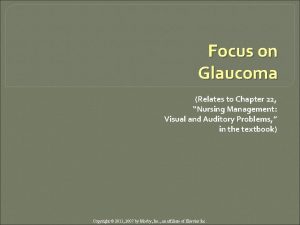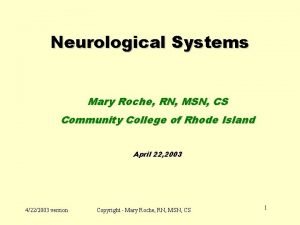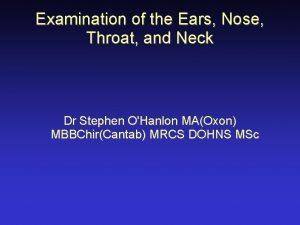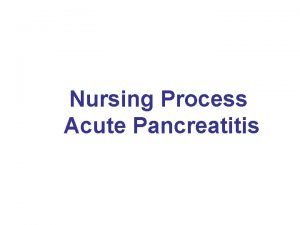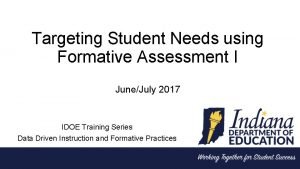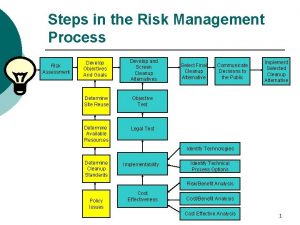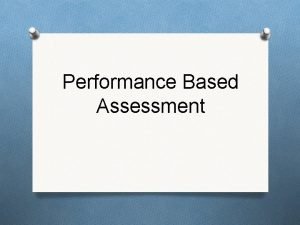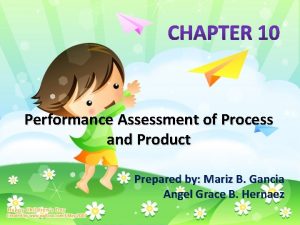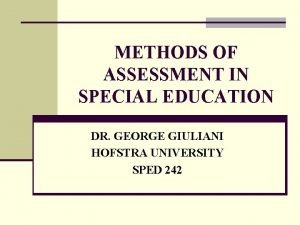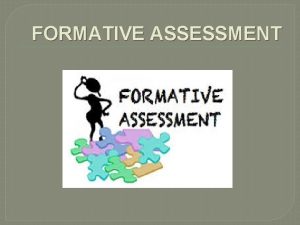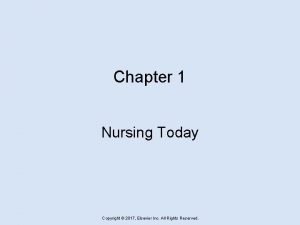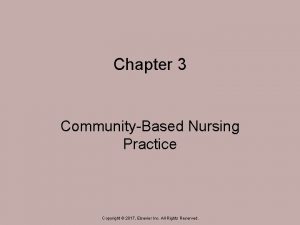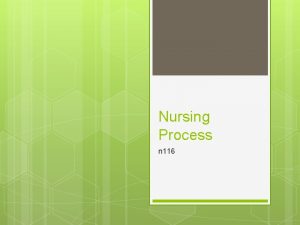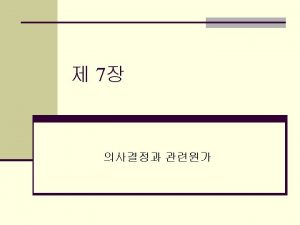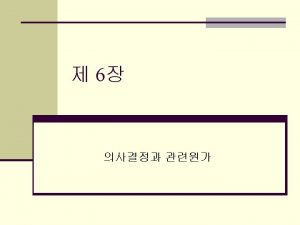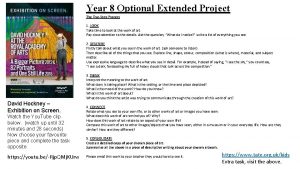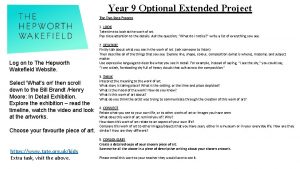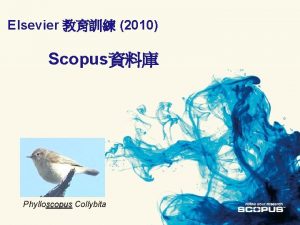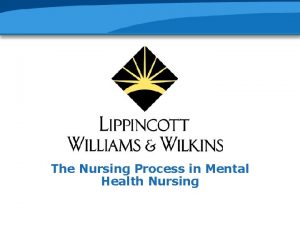Nursing Assessment FiveStep Nursing Process Copyright 2017 Elsevier






































































































- Slides: 102

Nursing Assessment

Five-Step Nursing Process Copyright © 2017, Elsevier Inc. All Rights Reserved. 2

Critical Thinking Approach to Assessment involves collecting information from the patient and from secondary sources (e. g. , family members), along with interpreting and validating the information to form a complete database. o Two stages of assessment: n Collection and verification of data n Analysis of data Copyright © 2017, Elsevier Inc. All Rights Reserved. 3

Critical Thinking Approach to Assessment (Cont. ) Copyright © 2017, Elsevier Inc. All Rights Reserved. 4

Case Study o Ms. Carla Thompkins, a 52 -year-old schoolteacher, is being admitted to the medical -surgical unit as a postop patient recovering from a below-the-knee amputation (BKA) secondary to complications of type 2 diabetes. o Ms. Thompkins is admitted to the unit not only so her recovery from the BKA may be monitored, but also because she is going to receive preliminary occupational and physical therapy to help her adapt to the amputation. Copyright © 2017, Elsevier Inc. All Rights Reserved. 5

Developing the Nurse-Patient Relationship for Data Collection o Sources of data n Patient (interview, observation, physical examination)—the best source of information n Family and significant others (obtain patient’s agreement first) n Health care team n Medical records n Scientific literature o Database Copyright © 2017, Elsevier Inc. All Rights Reserved. 6

Types of Assessments o Types include n the patient-centered interview during a nursing health history. n a physical examination. n the periodic assessments you make during rounding or administering care. Copyright © 2017, Elsevier Inc. All Rights Reserved. 7

Types of Assessments (Cont. ) Copyright © 2017, Elsevier Inc. All Rights Reserved. 8

Types of Assessments (Cont. ) Copyright © 2017, Elsevier Inc. All Rights Reserved. 9

Types of Data o Subjective n Patient’s verbal descriptions of their health problems o Objective n Observations or measurements of a patient’s health status Copyright © 2017, Elsevier Inc. All Rights Reserved. 10

Case Study (Cont. ) o Yolanda is the student nurse who has been assigned to admit Ms. Thompkins. o Yolanda enters Ms. Thompkins’ room, introduces herself, and begins the admission health history and physical assessment. During the assessment, Ms. Thompkins complains of pain at the incision site. Copyright © 2017, Elsevier Inc. All Rights Reserved. 11

Sources of Data Patient Family and significant others Health care team Medical records Other records and the scientific literature o Nurse’s experience o o o Copyright © 2017, Elsevier Inc. All Rights Reserved. 12

The Patient-Centered Interview o o Motivational interviewing Effective communication Interview preparation Phases of an interview n Orientation and setting an agenda n Working phase n Termination Copyright © 2017, Elsevier Inc. All Rights Reserved. 13

Interview Techniques o o o Observation Open-ended questions Leading questions Back channeling Direct closed-ended questions Copyright © 2017, Elsevier Inc. All Rights Reserved. 14

Nursing Health History o During the patientcentered interview you will learn which components of history to explore Copyright © 2017, Elsevier Inc. All Rights Reserved. 15

Cultural Considerations o To conduct an accurate and complete assessment, you need to consider a patient’s cultural background. o When cultural differences exist between you and a patient, respect the unfamiliar and be sensitive to a patient’s uniqueness. o If you are unsure about what a patient is saying, ask for clarification to prevent making the wrong diagnostic conclusion. Copyright © 2017, Elsevier Inc. All Rights Reserved. 16

Observation of Patient Behavior o It is important to closely observe a patient’s verbal and nonverbal behaviors. n Adds depth to objective database o Observations direct you to gather additional objective information to form accurate conclusions about the patient’s condition. o An important aspect of observation includes a patient’s level of function: the physical, developmental, psychological, and social aspects of everyday living. Copyright © 2017, Elsevier Inc. All Rights Reserved. 17

Nursing Health History (Cont. ) o Diagnostic and laboratory data n Results provide further explanation of alterations or problems identified during the health history and physical examination o Interpreting and validating assessment data n Ensures collection of complete database n Leads to second step of nursing process Copyright © 2017, Elsevier Inc. All Rights Reserved. 18

Nursing Health History (Cont. ) o Data documentation n Use clear, concise appropriate terminology n Becomes baseline for care o Concept mapping n Visual representation that allows you to graphically show the connections among a patient’s many health problems Copyright © 2017, Elsevier Inc. All Rights Reserved. 19

Case Study (Cont. ) o Yolanda asks Ms. Thompkins a series of questions about her pain, including: n “Describe your pain to me. ” n “Is the pain worse in the morning or in the evening? ” n “Place your hand over the area that is uncomfortable. ” n “Rate your pain on a scale of 0 to 10. ” Copyright © 2017, Elsevier Inc. All Rights Reserved. 20

Case Study (Cont. ) o Yolanda knows that the best source of information regarding Ms. Thompkins’ care is the surgeon. Copyright © 2017, Elsevier Inc. All Rights Reserved. 21

Chapter 17 Nursing Diagnosis Copyright © 2017, Elsevier Inc. All Rights Reserved.

History of Nursing Diagnosis o First introduced in 1950. o In 1953, Fry proposed the formulation of a nursing diagnosis. o In 1973, first national conference held. o In 1980 and 1995, the American Nurses Association (ANA) included diagnosis as a separate activity in its publication Nursing: a Social Policy Statement. o In 1982, North American Nursing Diagnosis Association (NANDA) was founded. 23 Copyright © 2017, Elsevier Inc. All Rights Reserved.

Case Study o John is a first semester nursing student who is particularly interested in heart disease since his father died of a heart attack at age 48. John decided to go into nursing because of his father’s death. He wanted to select a career that improves people’s lives. o John is studying the steps of the nursing process. He knows this information will help him care for cardiac patients in the future. 24 Copyright © 2017, Elsevier Inc. All Rights Reserved.

Types of Nursing Diagnoses o NANDA-I (2014) nursing diagnoses include: n Problem-focused n Risk n Health promotion 25 Copyright © 2017, Elsevier Inc. All Rights Reserved.

Case Study (Cont. ) o John reviews the phases of the nursing process, and attempts to put them in the correct order. 26 Copyright © 2017, Elsevier Inc. All Rights Reserved.

Critical Thinking and the Nursing Diagnostic Process o The diagnostic process requires you to use critical thinking. n Helps to be thorough, comprehensive, and accurate when identifying nursing diagnoses that apply to your patients. o The diagnostic reasoning process involves using the assessment data gathered about a patient to logically explain a clinical judgment or a nursing diagnosis. 27 Copyright © 2017, Elsevier Inc. All Rights Reserved.

Data Clustering o A data cluster is a set of cues, the signs or symptoms gathered during assessment. o Data clusters are compared with standards to reach a conclusion about a patient’s response to a health problem. o Each clinical criterion is an objective or subjective sign, symptom, or risk factor that, when analyzed with other criteria, leads to a diagnostic conclusion. 28 Copyright © 2017, Elsevier Inc. All Rights Reserved.

Case Study (Cont. ) o Because of John’s interest in cardiac nursing, he is familiar with the clinical criteria for heart disease. He is helping Beth, another fundamentals student, understand them as well. She tells him, “Hypertension, fatigue, preferring fried foods, and high cholesterol are all clinical criteria for heart disease, right? ” o John shakes his head. “Not quite, ” he says. 29 Copyright © 2017, Elsevier Inc. All Rights Reserved.

Data Interpretation o It is critical to select the correct diagnostic label for a patient’s need. o When comparing patterns, judge whether the grouped signs and symptoms are expected for a patient (e. g. , consider current condition, history) and whether they are within the range of healthy responses. n By isolating any defining characteristics not within healthy norms, you can identify a specific problem. 30 Copyright © 2017, Elsevier Inc. All Rights Reserved.

Formulating a Nursing Diagnosis Statement o Identify the correct diagnostic label with associated defining characteristics or risk factors and a related factor. o A related factor allows you to individualize a nursing diagnosis for a specific patient. Copyright © 2017, Elsevier Inc. All Rights Reserved. 31

Formulating a Nursing Diagnosis Statement (Cont. ) o Most settings use a two-part format in labeling health promotion and problemfocused nursing diagnoses. o Some agencies prefer a three-part nursing diagnostic label: n Problem n Etiology n Symptoms 32 Copyright © 2017, Elsevier Inc. All Rights Reserved.

Case Study (Cont. ) o John is trying to remember the four types of nursing diagnoses. He knows this is something Beth has mastered, so he asks her about it, “Are the four types of nursing diagnosis actual, risk, wellness, and disease prevention? ” 33 Copyright © 2017, Elsevier Inc. All Rights Reserved.

Cultural Relevance of Nursing Diagnoses o Consider patients’ cultural diversity when selecting a nursing diagnosis. Ask questions such as: n How has this health problem affected you and your family? n What do you believe will help or fix the problem? n What worries you most about the problem? n Which cultural practices are important to you? o Cultural awareness and sensitivity improve your accuracy in making nursing diagnoses. 34 Copyright © 2017, Elsevier Inc. All Rights Reserved.

Case Study (Cont. ) o After his study session with Beth, John has a better handle on nursing diagnoses. He knows that a _______ diagnosis is applied to vulnerable populations. 35 Copyright © 2017, Elsevier Inc. All Rights Reserved.

Concept Mapping Nursing Diagnosis o A concept map helps you critically think about a patient’s diagnoses and how they relate to one another. n Helps organize and link data about a patient’s multiple diagnoses in a logical way. n Graphically represents the connections among concepts that relate to a central subject. 36 Copyright © 2017, Elsevier Inc. All Rights Reserved.

Sources of Diagnostic Error o Errors occur during: n n 37 Data collection Interpretation and analysis of data Clustering Diagnostic statement Copyright © 2017, Elsevier Inc. All Rights Reserved.

Sources of Diagnostic Error (Cont. ) 1. Identify the patient’s response, not the medical diagnosis. 2. Identify a NANDA-I diagnostic statement rather than the symptom. 3. Identify a treatable cause or risk factor rather than a clinical sign or chronic problem that is not treatable through nursing intervention. 4. Identify the problem caused by the treatment or diagnostic study rather than the treatment or study itself. 5. Identify the patient response to the equipment rather than the equipment itself. 38 Copyright © 2017, Elsevier Inc. All Rights Reserved.

Sources of Diagnostic Error (Cont. ) 6. Identify the patient’s problems rather than your problems with nursing care. 7. Identify the patient problem rather than the nursing intervention. 8. Identify the patient problem rather than the goal of care. 9. Make professional rather than prejudicial judgments. 10. Avoid legally inadvisable statements. 11. Identify the problem and its cause to avoid a circular statement. 12. Identify only one patient problem in the diagnostic statement. 39 Copyright © 2017, Elsevier Inc. All Rights Reserved.

Documentation and Informatics o Once you identify a patient’s nursing diagnoses, enter them either on the written plan of care or in the electronic health information record (EHR) of the agency. n Computer helps organize data into clusters n Enhances ability to select accurate diagnoses o When initiating an original care plan, place the highest-priority nursing diagnosis first. 40 Copyright © 2017, Elsevier Inc. All Rights Reserved.

Nursing Diagnosis: Application to Care Planning o By learning to make accurate nursing diagnoses, your care plan will help communicate the patient’s health care problems to other professionals. o A nursing diagnosis will ensure that you select relevant and appropriate nursing interventions. 41 Copyright © 2017, Elsevier Inc. All Rights Reserved.

Chapter 18 Planning Nursing Care Copyright © 2017, Elsevier Inc. All Rights Reserved.

Establishing Priorities o Ordering of nursing diagnoses or patient problems uses determinations of urgency and/or importance to establish a preferential order for nursing interventions. o Organization of a vision of desired outcomes. o Classification of priorities: n High—Emergent n Intermediate—non-life-threatening n Low—Affect patient’s future well-being 43 Copyright © 2017, Elsevier Inc. All Rights Reserved.

Establishing Priorities (Cont. ) o The order of priorities changes as a patient’s condition changes. o Priority setting begins at a holistic level when you identify and prioritize a patient’s main diagnoses or problems. o Patient-centered care requires you to know a patient’s preferences, values, and expressed needs. o Ethical care is a part of priority setting. 44 Copyright © 2017, Elsevier Inc. All Rights Reserved.

Priorities in Practice 45 Copyright © 2017, Elsevier Inc. All Rights Reserved.

Case Study o Fulmala is a first semester nursing student who is assigned to Ms. Nadine Skyfall, a 35 -year-old American Indian patient diagnosed with severe anemia secondary to a bleeding peptic ulcer. Ms. Skyfall experiences pain because of the ulcer and weakness and fatigue resulting from the anemia. o Fulmala develops Ms. Skyfall’s plan of care, which addresses pain, weakness, fatigue, nutrition, and patient safety. 46 Copyright © 2017, Elsevier Inc. All Rights Reserved.

Critical Thinking in Setting Goals and Expected Outcomes o Goal n A broad statement that describes the desired change in a patient’s condition, perceptions, or behavior n An aim, intent, or end o Expected outcome n Measurable change that must be achieved to reach a goal n Many times, several must be met to meet a single goal 47 Copyright © 2017, Elsevier Inc. All Rights Reserved.

Critical Thinking in Setting Goals and Expected Outcomes (Cont. ) 48 Copyright © 2017, Elsevier Inc. All Rights Reserved.

Role of the Patient in Goal/Outcome Setting o Always partner with patients when setting their individualized goals. o Mutual goal setting includes the patient and family (when appropriate) in prioritizing the goals of care and developing a plan of action. o Act as a patient advocate. 49 Copyright © 2017, Elsevier Inc. All Rights Reserved.

Setting Goals and Expected Outcomes o Patient-centered goal: n A patient’s highest possible level of wellness and independence in function, based on patient needs, abilities, and resources o Nursing-sensitive patient outcome n A measurable patient, family, or community state, behavior, or perception largely influenced by and sensitive to nursing interventions o Nursing Outcomes Classification (NOC) n Links outcomes to NANDA-I nursing diagnoses 50 Copyright © 2017, Elsevier Inc. All Rights Reserved.

Writing Goals and Expected Outcomes o Must be patient-centered o Use SMART acronym n n n 51 Specific Measurable Attainable Realistic Timed Copyright © 2017, Elsevier Inc. All Rights Reserved.

Critical Thinking in Planning Nursing Care o Nursing interventions are treatments or actions based on clinical judgment and knowledge that nurses perform to enhance patient outcomes. o Nurses need to: n Know the scientific rationale for the intervention n Possess the necessary psychomotor and interpersonal skills n Be able to function within a setting to use health care resources effectively 52 Copyright © 2017, Elsevier Inc. All Rights Reserved.

Types of Interventions o Nurse-initiated n Independent—Actions that a nurse initiates o Health care provider initiated n Dependent—Require an order from a physician or other health care professional o Collaborative n Interdependent—Require combined knowledge, skill, and expertise of multiple health care professionals 53 Copyright © 2017, Elsevier Inc. All Rights Reserved.

Types of Interventions (Cont. ) o When preparing for physician-initiated or collaborative interventions, do not automatically implement therapy, but determine whether it is appropriate for the patient. o The ability to recognize incorrect therapies is particularly important when administering medications or implementing procedures. 54 Copyright © 2017, Elsevier Inc. All Rights Reserved.

Case Study (Cont. ) o Fulmala develops Ms. Skyfall’s plan of care, including writing the goals and expected outcomes. o Fulmala knows that the guidelines for writing goals and expected outcomes include that they be measurable, time -limited, observable, and realistic. 55 Copyright © 2017, Elsevier Inc. All Rights Reserved.

Selection of Interventions o Six factors to consider: Desired patient outcomes Characteristics of the nursing diagnosis Research-based knowledge for the intervention Feasibility of the interventions Acceptability to the patient Nurse’s competency 56 Copyright © 2017, Elsevier Inc. All Rights Reserved.

Nursing Interventions Classification (NIC) o The Iowa Intervention Project developed a set of nursing interventions that provides a level of standardization to enhance communication of nursing care across health care settings and to compare outcomes. o The NIC model includes three levels—domains, classes, and interventions—for ease of use. o NIC interventions are linked with NANDA International nursing diagnoses. 57 Copyright © 2017, Elsevier Inc. All Rights Reserved.

Case Study (Cont. ) o Fulmala knows that _________ interventions require an order from a physician or another health care professional. 58 Copyright © 2017, Elsevier Inc. All Rights Reserved.

Systems for Planning Nursing Care o Nursing care plan = Nursing diagnoses, goals and expected outcomes, and nursing interventions, and a section for evaluation findings so any nurse is able to quickly identify a patient’s clinical needs and situation n Reduces the risk for incomplete, incorrect, or inaccurate care n Changes as the patient’s problems and status change o Interdisciplinary care plan = Contributions from all disciplines involved in patient care 59 Copyright © 2017, Elsevier Inc. All Rights Reserved.

Hand-Off Reporting o A critical time, when nurses collaborate and share important information that ensures the continuity of care for a patient and prevents errors or delays in providing nursing interventions o Transferring essential information from one nurse to the next during transitions in care o Ask questions, clarify, and confirm important details about a patient’s progress and continuing care needs 60 Copyright © 2017, Elsevier Inc. All Rights Reserved.

Student Care Plans o A student care plan n Helps you apply knowledge gained from the nursing and medical literature and the classroom to a practice situation n Is more elaborate than a care plan used in a hospital or community agency because its purpose is to teach the process of planning care o Planning care for patients in community-based settings involves n Educating the patient/family about care n Guiding them to assume more of the care over time 61 Copyright © 2017, Elsevier Inc. All Rights Reserved.

Critical Pathways o Critical pathways are patient care plans that provide the multidisciplinary health care team with activities and tasks to be put into practice sequentially. o The main purpose of critical pathways is to deliver timely care at each phase of the care process for a specific type of patient. 62 Copyright © 2017, Elsevier Inc. All Rights Reserved.

Concept Maps o Visual representation of all of a patient’s nursing diagnoses that allows you to diagram interventions for each o Group and categorize nursing concepts to give you a holistic view of your patient’s health care needs and help you make better clinical decisions in planning care o Help you learn the interrelationships among nursing diagnoses to create a unique meaning and organization of information 63 Copyright © 2017, Elsevier Inc. All Rights Reserved.

Case Study (Cont. ) o Fumala writes down several independent nursing interventions that she is developing for Ms. Skyfall. 64 Copyright © 2017, Elsevier Inc. All Rights Reserved.

Consulting Other Health Care Professionals o Planning involves consultation with members of the health care team. o Consultation is a process by which you seek the expertise of a specialist such as your nursing instructor, a physician, or a clinical nurse educator to identify ways to handle problems in patient management or in planning and implementation of therapies. o Consultation occurs at any step in the nursing process, most often during planning and implementation. 65 Copyright © 2017, Elsevier Inc. All Rights Reserved.

When and How to Consult o When: The exact problem remains unclear How: Begin with your understanding of the patient’s clinical problem. Direct the consultation to the right professional. Provide the consultant with relevant information about the problem area: summary, methods used to date, and outcomes Do not influence consultants. Be available to discuss the consultant’s Copyright © 2017, Elsevier Inc. All Rights 66 findings. Reserved.

Case Study (Cont. ) o Fumala’s clinical coordinator tells her to coordinate with a nutritionist to develop a meal plan for Ms. Skyfall. 67 Copyright © 2017, Elsevier Inc. All Rights Reserved.

Chapter 19 Implementing Nursing Care Copyright © 2017, Elsevier Inc. All Rights Reserved.

Case Study o Miranda is a nursing student who is assigned to Mr. Bagley is a 52 -year-old Asian who was admitted to the medicalsurgical unit for management of tuberculosis. Mr. Bagley travels internationally because of his executive position with a global company and most likely contracted tuberculosis during his travels. o Mr. Bagley’s current symptoms are shortness of breath, night sweats, muscle pain, fatigue, and a productive cough. Miranda reviews Mr. Bagley’s plan of care to determine which 69 interventions are to be implemented first.

Standard Nursing Interventions o Standardized interventions most often set a level of clinical excellence for practice o Nurse- and health care provider–initiated standardized interventions are available in the form of clinical guidelines or protocols, preprinted (standing) orders, and Nursing Interventions Classification (NIC) interventions o American Nurses Association (ANA) standards o Quality and Safety Education for Nurses (QSEN) skill competencies 70 Copyright © 2017, Elsevier Inc. All Rights Reserved.

Standard Nursing Interventions (Cont. ) o Clinical practice guidelines and protocols n A systematically developed set of statements that helps nurses, physicians, and other health care providers make decisions about appropriate health care for specific clinical situations o Standing orders n Preprinted document containing orders for the conduct of routine therapies, monitoring guidelines, and/or diagnostic procedures for specific patients with identified clinical problem 71 Copyright © 2017, Elsevier Inc. All Rights Reserved.

Standard Nursing Interventions (Cont. ) o Nursing interventions classification interventions n Differentiates nursing practice from that of other health care disciplines by offering a language that nurses use to describe a set of actions in delivering nursing care o Standards of practice n Used as evidence of the standard of care that registered nurses (RNs) provide their patients o Quality and safety education for nurses 72 Copyright © 2017, Elsevier Inc. All Rights Reserved.

Critical Thinking in Implementation o Clinical judgment n Includes making appropriate conclusions about interventions to address a patient’s response to health conditions or a life process n Requires nurse to use or modify standard approaches, sometimes improvise new ones 73 Copyright © 2017, Elsevier Inc. All Rights Reserved.

Critical Thinking in Implementation (Cont. ) 74 Copyright © 2017, Elsevier Inc. All Rights Reserved.

Critical Thinking in Implementation (Cont. ) o Tips for making decisions during implementation: n Review the set of all possible nursing interventions for a patient’s problem n Review all possible consequences associated with each possible nursing action n Determine the probability of all possible consequences n Judge the value of the consequence to the patient 75 Copyright © 2017, Elsevier Inc. All Rights Reserved.

Implementation Process o Reassessing a patient n Continuous process with each patient interaction o Reviewing and revising the existing nursing care plan n Allows you to validate a patient’s nursing diagnoses, review the care plan, and determine whether the nursing interventions remain the most appropriate for the patient’s needs 76 Copyright © 2017, Elsevier Inc. All Rights Reserved.

Implementation Process (Cont. ) o Preparing for implementation n n 77 Time management Equipment Personnel Environment Patient Copyright © 2017, Elsevier Inc. All Rights Reserved.

Anticipating and Preventing Complications o Preventing complications n Identify risks to the patient n Adapt interventions to the situation n Evaluate the relative benefit of a treatment vs. the risk n Initiate risk-prevention measures o Identifying areas of assistance n Seek information about a procedure n Collect all necessary equipment n Ask another nurse provide assistance and guidance 78 Copyright © 2017, Elsevier Inc. All Rights Reserved.

Implementation Skills o You are responsible for knowing when one type of implementation skill is preferred over another and for having the necessary knowledge and skill to perform each. n Cognitive skills n Interpersonal skills n Psychomotor skills 79 Copyright © 2017, Elsevier Inc. All Rights Reserved.

Direct Care vs. Indirect Care Direct Care Indirect Care • Treatments performed through interactions with patients • Treatments performed away from the patient but on behalf of the patient or group of patients • Medication administration • Managing the patient’s • Insertion of an environment (e. g. , safety intravenous (IV) infusion and infection control) • Counseling during a time • Documentation of grief • Interdisciplinary collaboration 80 Copyright © 2017, Elsevier Inc. All Rights Reserved.

Case Study (Cont. ) o Miranda searches the hospital’s database for additional information on tuberculosis. n True or False: A clinical practice guideline is a collection of institutional policies that assist nurses, physicians, and other health care providers in making decisions about appropriate health care for specific clinical situations, such as the management of tuberculosis. 81 Copyright © 2017, Elsevier Inc. All Rights Reserved.

Direct Care o Activities of daily living (ADLs) n Performed in the course of a day, including ambulation, eating, dressing, bathing, and grooming o Instrumental ADLs (IADLs) n Skills such as shopping, preparing meals, house cleaning, writing checks, and taking medications. o Physical care techniques n The safe and competent administration of nursing procedures o Lifesaving measures 82 Copyright © 2017, Elsevier Inc. All Rights Reserved.

Direct Care (Cont. ) o Counseling o Teaching o Controlling for adverse reactions o Preventive measures Copyright © 2017, Elsevier Inc. All Rights Reserved. 83

Case Study (Cont. ) o Mr. Bagley’s plan of care calls for oxygen therapy to improve his respiratory status. n A preprinted document that contains orders for the conduct of routine therapies, such as oxygen therapy, is referred to as a _____________. 84 Copyright © 2017, Elsevier Inc. All Rights Reserved.

Indirect Care o Indirect care measures are nursing actions that manage the patient care environment and interdisciplinary collaborative actions that support the effectiveness of direct care interventions o Communicating nursing interventions n Written or oral o Delegating, supervising, and evaluating the work of other staff members 85 Copyright © 2017, Elsevier Inc. All Rights Reserved.

Case Study (Cont. ) o Mr. Bagley is placed on Isolation Precautions as a treatment intervention are an example of which type of care? A. Direct B. Indirect C. Prevention D. Safety 86 Copyright © 2017, Elsevier Inc. All Rights Reserved.

Achieving Patient Goals o Nurses implement care to meet patient goals. o At times, multiple interventions may be needed. o Priorities help nurses to anticipate and sequence nursing interventions. o Patient adherence means that patients and families invest time in carrying out required treatments. 87 Copyright © 2017, Elsevier Inc. All Rights Reserved.

Chapter 20 Evaluation Copyright © 2017, Elsevier Inc. All Rights Reserved.

Critical Thinking in Evaluation 89 Copyright © 2017, Elsevier Inc. All Rights Reserved.

Examine Results o Reflection-in-action n Once you deliver an intervention, you continuously examine results by gathering subjective and objective data from the patient, family, and health care team members. n At the same time you review knowledge regarding a patient’s current condition, the treatment, and the resources available for recovery. n By reflecting on previous experiences caring for similar patients, you are in a better position to know how to evaluate your patient. 90 Copyright © 2017, Elsevier Inc. All Rights Reserved.

Evaluative Measures o Evaluative measures are assessment skills and techniques o Evaluating behavior o Self-management o Nursing Outcomes Classification (NOC) Copyright © 2017, Elsevier Inc. All Rights Reserved. 91

Compare Achieved Effect with Goals and Outcomes o Compare clinical data, patient behavior measures, and patient selfreport measures collected before implementation with the evaluation findings gathered after administering nursing care. o Evaluate whether the results of care match the expected outcomes and goals set for a patient. 92 Copyright © 2017, Elsevier Inc. All Rights Reserved.

Compare Achieved Effect with Goals and Outcomes (Cont. ) 93 Copyright © 2017, Elsevier Inc. All Rights Reserved.

Case Study o Miyoko is a nursing student assigned to Mr. Mashoud, a 48 -year-old Arab admitted to the hospital with kidney stones. o Upon Mr. Mashoud’s admission to the emergency department (ED) this morning, he was experiencing excruciating pain. o The treatment plan for Mr. Mashoud includes keeping him in the hospital until he passes the stones and adjusting his pain medication as needed. 94 Copyright © 2017, Elsevier Inc. All Rights Reserved.

Case Study (Cont. ) o Miyoko evaluates Mr. Mashoud’s response to the medication therapy to update his care plan. Miyoko assesses Mr. Mashoud’s pain before NSAID administration and then approximately one hour after administration. n Miyoko knows that evaluation is an ______ process that occurs whenever contact with a patient occurs. 95 Copyright © 2017, Elsevier Inc. All Rights Reserved.

Interpreting and Summarizing Findings o When you evaluate the effect of interventions, you interpret or learn to recognize relevant evidence about a patient’s condition o Early detection is first line of defense o Compare actual and expected findings o Steps to objectively evaluate the degree of success in achieving outcomes of care 96 Copyright © 2017, Elsevier Inc. All Rights Reserved.

Recognize Errors or Unmet Outcomes o Must have an open mind, actively pursue truth, be patient and confident, and engage in selfreflection o Systematic use of evaluation o Self-reflection and correction of errors 97 Copyright © 2017, Elsevier Inc. All Rights Reserved.

Care Plan Revision o Discontinuing a care plan o Modifying a care plan n n 98 Reassessment Redefining diagnoses Goals and expected outcomes Interventions Copyright © 2017, Elsevier Inc. All Rights Reserved.

Standards for Evaluation o Nursing care helps patients • Resolve actual health problems • Prevent potential problems • Maintain a healthy state 99 Copyright © 2017, Elsevier Inc. All Rights Reserved.

Standards for Evaluation (Cont. ) o American Nurses Association (ANA) n Defines standards o Competencies include: Being systematic Using criterion-based evaluation Collaborating Using ongoing assessment data to revise care plan n Communicating results n n 100 Copyright © 2017, Elsevier Inc. All Rights Reserved.

Case Study (Cont. ) o Miyoko determines the patient outcomes for Mr. Mashoud based on his reaction to the medication regimen. n Which of the following is an end result that translates into observable patient behaviors that are measurable and desirable? A. Unexpected outcome B. Expected outcome C. Sensitive outcome D. Accomplished outcome 101 Copyright © 2017, Elsevier Inc. All Rights Reserved.

Standards for Evaluation (Cont. ) o Collaborate and evaluate effectiveness of interventions n Family n Health care team o Document results Copyright © 2017, Elsevier Inc. All Rights Reserved. 102
 Fivestep
Fivestep Fivestep
Fivestep Copyright secondary sara (2017) answers
Copyright secondary sara (2017) answers Dependent intervention nursing
Dependent intervention nursing Icass practical assessment task 1 2017 memorandum
Icass practical assessment task 1 2017 memorandum Assessment and reporting arrangements 2017
Assessment and reporting arrangements 2017 Psychiatric nursing diagnosis
Psychiatric nursing diagnosis Nursing process in psychiatric nursing
Nursing process in psychiatric nursing Tfs process template editor
Tfs process template editor Statdx elsevier
Statdx elsevier Ees elsevier
Ees elsevier Springer elsevier
Springer elsevier Elsevier clinical solutions
Elsevier clinical solutions Elsevier 2005
Elsevier 2005 Pancreas divisum surgery
Pancreas divisum surgery Descending limb of nephron loop
Descending limb of nephron loop General sense
General sense Elsevier
Elsevier Copyright
Copyright Ees elsevier
Ees elsevier Hs and ts
Hs and ts Picture for newborn
Picture for newborn Elsevier
Elsevier Elsevier
Elsevier Elsevier
Elsevier Http://journalfinder.elsevier.com
Http://journalfinder.elsevier.com Raexys
Raexys Elsevier
Elsevier Elsevier
Elsevier Precordium
Precordium Elsevier
Elsevier Ees elsevier
Ees elsevier Springer, elsevier, taylor & francis etc. are ______. *
Springer, elsevier, taylor & francis etc. are ______. * Reaxys elsevier
Reaxys elsevier Chapter 8 skin disorders and diseases
Chapter 8 skin disorders and diseases Chapter 52 removable prosthodontics multiple choice
Chapter 52 removable prosthodontics multiple choice Elsevier
Elsevier Elsevier
Elsevier Elsevier
Elsevier Elsevier
Elsevier Elsevier
Elsevier Elsevier
Elsevier Utero
Utero Chapter 7:4 skeletal system
Chapter 7:4 skeletal system Hivebench
Hivebench Saunders
Saunders Chapter 9 general survey and measurement
Chapter 9 general survey and measurement Expertpath
Expertpath Elsevier
Elsevier Elsevier profile
Elsevier profile Elsevier
Elsevier Divisions of the large intestine
Divisions of the large intestine Elsevier
Elsevier Elsevier
Elsevier Elsevier
Elsevier Elsevier
Elsevier Elsevier
Elsevier What is the purpose of provisional coverage?
What is the purpose of provisional coverage? Matrix band definition
Matrix band definition Elsevier
Elsevier Elsevier
Elsevier Elsevier
Elsevier Copyright
Copyright Caslick definition
Caslick definition Elsevier
Elsevier Elsevier
Elsevier Elsevier san diego
Elsevier san diego Elsevier
Elsevier When does milk come in
When does milk come in Burns elsevier
Burns elsevier Principles of portfolio assessment
Principles of portfolio assessment Define dynamic assessment
Define dynamic assessment Portfolio assessment matches assessment to teaching
Portfolio assessment matches assessment to teaching Treatment of ocd
Treatment of ocd Assessment of hematologic system
Assessment of hematologic system Turgor nursing assessment
Turgor nursing assessment Newborn assessment nursing
Newborn assessment nursing Nursing assessment for congestive heart failure
Nursing assessment for congestive heart failure Right sided heart failure
Right sided heart failure What are the determinants of learning
What are the determinants of learning Nursing diagnosis examples
Nursing diagnosis examples Nursing assessment of breast cancer
Nursing assessment of breast cancer Chapter 21 assessment and management auditory problems
Chapter 21 assessment and management auditory problems The nursing process organizes your approach
The nursing process organizes your approach Ostonies
Ostonies Pediatric physical assessment nursing
Pediatric physical assessment nursing Pancreatitis nursing
Pancreatitis nursing Nursing assessment definition
Nursing assessment definition Perioperative vs preoperative
Perioperative vs preoperative Glaucoma nursing management
Glaucoma nursing management Purpose of nursing assessment
Purpose of nursing assessment Neuro assessment nursing
Neuro assessment nursing Nursing blood pressure assessment
Nursing blood pressure assessment Posterior rhinoscopy
Posterior rhinoscopy Pancreatitis assessment nursing
Pancreatitis assessment nursing Process based assessment
Process based assessment Formative assessment process
Formative assessment process Steps in risk management process
Steps in risk management process What are the features of performance based assessment
What are the features of performance based assessment Design a museum exhibit holistic rubric
Design a museum exhibit holistic rubric Process and product assessment
Process and product assessment Assessment process in special education
Assessment process in special education évaluation formative
évaluation formative
